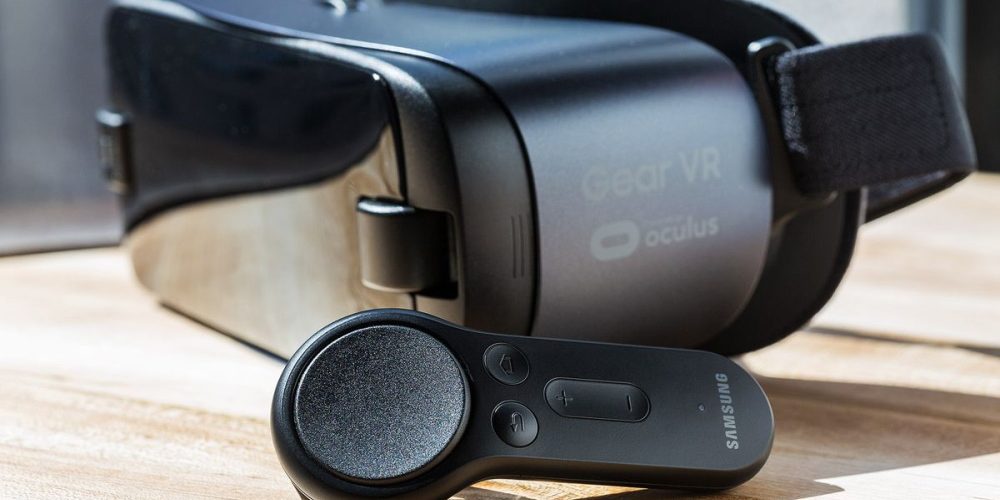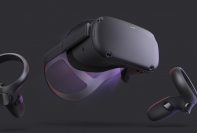The Samsung Gear VR holds a fond place in many hearts thanks to its status as a mobile VR pioneer but the Oculus Quest 2 is the splashy new headset on the scene and it’s already making waves.
No, not because of Facebook’s controversial account policies, but because the headset is actually genuinely impressive.
Even so, you might be wondering whether the Quest 2 is for you or if you should either stick to the Gear VR (if you already own one) or get one instead since they’re a little lighter on the pocket.
Well, today’s your lucky day because we’re taking a look at what each of these headsets have to offer.
| Gear VR | Oculus Quest 2 | |
| Tracking | 3DOF tracking | 6DOF Inside-Out Tracking |
| Processor | Depends on the inserted smartphone | Qualcomm’s Snapdragon XR2 Chip |
| Lens per Eye Resolution | 1280 x 1440* | 1,832 × 1,920 |
| Display | Depends on the inserted smartphone | LCD |
| Refresh Rate | 60Hz | 72Hz / 90Hz |
| Memory | Depends on the inserted smartphone | 6GB of RAM |
| Storage | Depends on the inserted smartphone | 64 GB / 256 GB |
| Battery Life | Depends on the battery life of the inserted smartphone | 2 -3 hours |
*The resolution you’re going to get with the Gear VR also greatly depends on the smartphone you’re using.
Seeing as the Quest 2 has one of the best resolutions of any VR device currently on the market, there’s just no way the Samsung Gear VR can keep up with that.
You have likely already guessed as much anyway, as the Gear VR is a pretty old piece of hardware in VR terms (the first consumer version was released in 2015) while the Quest 2 is Facebook’s latest flagship device.
The Gear VR has a 101° field of view (FOV) while the Quest 2 has a FOV of 92° (H), 90° (V), 129° (D).
Having a bigger FOV means you have a bigger observable environment at any given time while using the headset.
A bigger play area means you’re able to do a lot more within that area without losing track of your controllers or environment, which leads to greater immersion.
So its definitely one of the more important aspects of VR gaming.
Interpupillary distance (IPD) on the Gear VR is also fixed, while the Quest 2 has three IPD settings, which Facebook says should be able to accommodate most people.
Not only will this provide a more comfortable experience, but will also help with the clarity of the images you’re going to see.
As for processing power, it’s really hard to compare the two, because the Gear VR doesn’t have a processor of its own and relies on the smartphone plugged into it.
That said, most of the smartphones that the Gear VR supports don’t come close to the Quest 2 in terms of processing power and so it’s very unlikely that you’ll get the same level of performance out of any Gear VR experience.
When it comes to battery life and storage, these factors once again depend on the smartphone you’re using the Gear VR with as it doesn’t have its own onboard hardware.
One thing is clear though, the specs on the Quest 2 are arguably some of the best on any standalone headset available today.
So, even though there’s no real way to compare the two on this front unless you compare it with a specific smartphone’s specs, there’s little chance any smartphone combo you’re going to use with the Gear VR will trump the Quest 2 on the hardware front.
Degrees of freedom is probably the biggest difference, besides the visual quality, that you’ll notice between the two.
The Gear VR only provides 3DOF, which means that you can look around in a virtual world, but everything is centered around you and you cannot move within the world.
6DOF, on the other hand, is really where its at for VR right now, as this provides you with the ability to move around and interact with the virtual world you’re in.
It makes a massive difference in the level of immersion you’ll feel, as well as the type of interactions you’ll be able to make in-game.
For that reason alone, the Quest 2 already outstrips the Gear VR by leagues.
Convenience and Accessibility
Obviously, both the Gear VR and Quest 2’s biggest selling point is that they’re standalone devices.
With either, you’re able to get things started quickly and jump into experiences with minimal effort.
Although, the Gear VR does require that you get your phone set up and into the headset first, which can take a bit more time.
Luckily it’s very straightforward and user-friendly nonetheless.
Since they both work as standalone headsets, the Gear VR and Quest 2 can easily be packed up and taken along with you wherever you go.
You’re also not confined to any room or area as you would be with a tethered VR headset.
That said, if you’re looking for something that’s more flexible and will provide you with equally great standalone and tethered experiences then the Gear VR isn’t going to be the headset for you.
The Quest 2, however, provides an incredibly agile experience and you can use it whichever way you see fit or as the situation requires – so long as you buy the Oculus Link cable to connect to a PC via USB of course.
Comfort
Unfortunately, the original Oculus Quest was already known for being quite uncomfortable and that trend continues with the Quest 2.
It’s regrettable because the rest of the headset fares exceptionally well against most of today’s low-, mid-, and even some high-tier VR headsets.
Yet Facebook has dropped the ball when it comes to the headset’s overall design and comfort.
Their decision is a little baffling, but it might be the result of some scrimping on their part to save money.
The Gear VR is lighter than the Quest 2 at 318g vs 503 g, although the smartphone you add onto the Gear VR adds quite a bit of weight too.
Even so, with a smartphone attached, the weight on the Gear VR doesn’t feel like as much of a problem and it’s still more comfortable to wear for extended periods of time than the Quest 2.
That’s because, the straps on the Quest don’t support the weight of the headset as well as they ideally should, leading to much of its weight resting on your nose and cheeks, even if you tighten the straps.
Facebook went with more flexible straps on the Quest 2 than on the first headset, and in some ways that’s better because these fit more comfortably around the shape of your head, but they do virtually nothing to hold the headset up.
That’s a shame because it starts to get uncomfortable after around 10 minutes, which is a fraction of the time that most people will want to spend with the headset on – especially if they’re playing longer AAA games.
Don’t think that the Gear VR is perfect in this area, however.
It suffers from the same issue to a degree, as a big chunk of its weight rests squarely on the bridge of your nose and that gets uncomfortable fast.
Thankfully, it’s a little easier to adjust the straps on the Gear VR to find that sweet spot – which is possible with the Quest 2 as well, though it might take some more fiddling.
If you’re not up for that amount of effort just to get comfortable while wearing your headset (and who could blame you) then there is the option to buy an Elite Strap or Elite Battery Strap for the Quest 2.
Obviously, that means you’ll have to shell out some more cash for the headset, though.
Controllers
No two VR controllers are cut from the same cloth and nowhere is this more starkly apparent than when you try to compare the controllers of these two headsets.
Really, the Quest 2 controllers are in a whole different realm than the Gear VR controller and there’s simply no way you’ll ever get close to the same experience between these two.
The Gear VR originally released without a controller, but one was later added to give people an alternative to that silly little trackpad on the side of the headset.
This helped with the immersion too, of course. It features a trackpad similar to those on the HTC Vive controllers, as well as a couple of indented buttons.
The controller itself is pretty small and limited in its abilities, but for what the Gear VR and its content are able to do, it gets the job done fairly well.
People with bigger hands might have some issues with comfort after a while though.
Things couldn’t be more different when it comes to the Quest 2 controllers.
The tracking is more snappy, for one, and you have that six degrees of freedom (6DOF) as well as a bigger FOV so you’re going to get a lot more mileage out of it.
The games that are designed for the Quest 2 as well as the PC VR games it supports can also provide a lot more variety and immersion because of this.
On top of that, you have two controllers (instead of just one) that are relatively big – they’re some of the biggest currently in the market – and the extra space on there really helps to avoid accidental button-pushing.
Plus those with bigger hands certainly aren’t going to find anything to complain about here. Although, anyone with smaller hands might notice them being a little too bulky.
Content Library
Samsung proudly boasts that the Gear VR headset has “ 1000+ apps and counting”.
That’s not at all a bad library size for a mobile VR headset, although they do count ‘experiences’ among that number, which tend to be short VR videos that may or may not be interactive.
So, in essence, you’ll find that the apps and games that support the Gear VR are simpler, entry-level experiences that the hardware on an Android phone will be able to run.
The Quest is a whole other beast since it can provide both standalone experiences and full-fledged PC VR content via the Oculus Link cable.
On the quest alone, you’re getting a whole long list of apps, games, and experiences thanks to Oculus’s extensive library, but if you add the cable and make use of SteamVR then you’re not just opening up a whole new avenue with thousands of games, but also AAA ones too.
Even so, while it’s easy to say that the Quest 2 wins out in terms of its content library, your preferences still have a big role to play here.
If you’re not much of a gamer and just want access to simple experiences and 360° videos then the Gear VR is still a solid option.
You might be less inclined to pay for the more expensive Quest 2 when you’re not going to be making use of everything it has to offer.
Price
Accurate price comparison is a little tricky because the production of the Gear VR has been officially discontinued as of 2019, and so you’ll likely have to settle for a second-hand device if you still want to get your hands on one.
If you had bought a brand new Gear VR in 2017 or 2018, then it would have set you back around $129 USD (bundled with the Gear VR controller, which costs $39 separately).
That’s not a bad price for an entry ticket into VR, so long as you had one of the smartphones it supports.
As for the Quest 2, it’s currently retailing at $299, which is cheaper than the original Quest and all of the other mid-tier and high-end VR headsets currently on the market.
Honestly, for everything you get with this headset, that’s a fantastic price range – even if you decide to include the Oculus Link cable or the comfier Elite straps.
Conclusion
Obviously, the Quest 2 pretty much crushes the Gear VR in almost every VR category seeing as it’s newer, provides better flexibility in terms of playstyle, and sports much better hardware.
The Gear VR had a good run and it provided a great low barrier to entry for a massive amount of people who wanted to dip their toes into virtual reality back when it just started becoming more mainstream in 2015.
But there are much better options now, as the Quest 2 clearly proves.
Normal workout, maintaining a healthy cardiform cena weight, and staying clear of long term sitting or standing are crucial in preserving excellent venous health and wellness.




